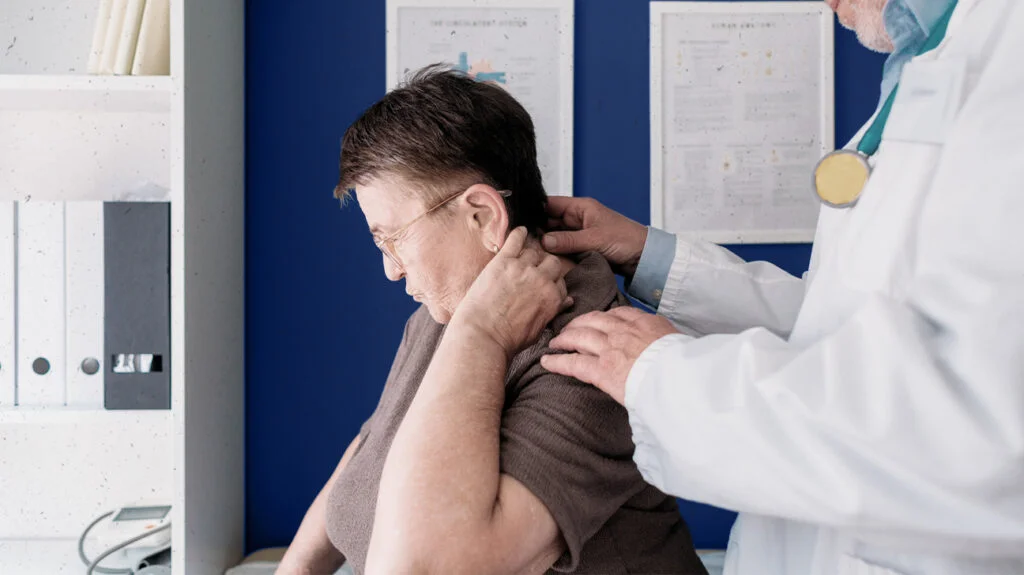Pain Management – This course is designed to understand the concept of community health nursing: nurses’ roles and interventions in family health, school health, occupational health, environmental health, elderly health care, gender issues, disaster management, and principles and terminology of epidemiology. The aim of the course is to acquire knowledge and skills in community health nursing.

Pain Management
Pain is an unpleasant sensory and emotional experience associated with actual or potential tissue damage, or described in terms of such damage.”
Or,
An unpleasant sensation that can range from mild, localized discomfort to agony. Pain has both physical and emotional components. The physical part of pain results from nerve stimulation.
Or,
Pain is a subjective feeling or individual response to noxious stimuli on the sensory nerve endings.
(Ref b by: IASP-International Association for the Study of Pain)
Classification of Pain:
A. According to time:
a) Acute pain; Occurs abruptly after an injury or disease. Persists until healing occurs and often is intensified by anxiety or fear. Examples-Bone fractures, bums, surgery, sickle cell crisis, tension headache, delivery.
b) Chronic pain: Pain lasts for a prolonged period of time. Cannot amenable to specific treatment. It is two types-
1. Chronic nociceptive pain.
- Prolong tissue pathology.
- Stable angina.
- Gastritis.
- Pancreatitis.
- Gout.
2. Chronic neuropathic pain.
- Abnormalities in the PNS or CNS.
- Low back pain.
- Diabetic neuropathy.
B. According to pathophysiology:
a) Nociceptive pain: Pain resulting from activation of primary afferent nociceptors by mechanical, thermal or chemical stimuli.
b) Neuropathic pain: Pain resulting from damage to peripheral nervous or central nervous system tissue or from altered processing of pain in the CNS.
C. According to the origin:
a) Superficial pain: Originate in the skin and subcutaneous tissue.
b) Deep somatic pain: Pain arises from ligament, tendon, blood vessels etc.
c) Visceral pain: Stimulation of pain receptor in the abdominal cavity, craniurn and thorax.
D. According to where it is experienced in the body:
a) Radiating pain.
b) Referred pain.
c) Phanthom pain.
d). Shifting pain.

Factors Influencing Pain in Children:
| Physical factors; | Many physical factors influence the pain experience, including the individual’s pain threshold, pain tolerance, age, physical activities, nervous-system integrity |
| Psychological factors: | Along with physical factors, several psychological factors can influence the response to pain, including culture, religion, past experience with pain, anxiety and situation factors |
PORST Method for Pain Assessment:
A. PProvokes
1. What causes pain?
2. What makes it better?
3. Worse?
B. Q = Quality
1. What does it feel like?
2. Is it sharp?
3. Dull?
4. Stabbing?
5. Burning?
6. Crushing? (Try to let patient describe the pain, sometimes they say what they think you would like to hear.)
C. R=Radiates
1. Where does the pain radiate?
2. Is it in one place?
3. Does it go anywhere else?
4. Did it start elsewhere and now localized to one spot?
D. S = Severity
1. How severe is the pain on a scale of 1-10?
2. (This is a difficult one as the rating will differ from patient to patient.)
E. T=Time
1. Time pain started?
2. How long did it last?

Other questions to ask and look for….
✔ Any medication or allergies?
✔Does it hurt on deep inspiration?
✔ Activity and onset?
✔ Any history of pain?
✔ Is it the same?
✔ Different?
✔ Any family history of heart disease lung problems, stroke or hypertension?
✔ Check LOC.
✔ Pupils?
✔ JVD?
✔ Midline trachea?
✔ Any recent trauma?
[Ref- Budassi-Sheehy, Emergency Nursing, Principles and Practice 3rd Ed., 1992 ]
Methods of Pain Assessment of a Child:
Because pain is both a sensory and an emotional experience, using several assessment strategies provides quality and quantitative information about pain.
QUEST is the best way to assess pain of a child.
- Q-Question the child
- U-Use a pain rating scale
- E-Evaluate the behaviour and physiological changes
- S-Secure parents involvement
- T-Take cause of pain into account
- T-Take action and evaluate result

Pain Related Terminologies:
Acute Pain
Definition: Pain that is usually temporary and results from something specific, such as a surgery, an injury, or an infection.
Clinical Use:
- Knowing if pain is acute rather than persistent guides treatment decisions
- Monitor acute pain for signs of improvement as expected
- Ineffectively treated acute pain can develop into persistent or chronic pain
Allodynia
Definition: A non-painful stimulus felt as painful in spite of normal-appearing tissues
Clinical Use:
- Common in many neuropathic pain conditions.
- An older adult experiencing allodynia may feel discomfort with the bed sheets resting on their feet or legs.
Breakthrough Pain
Definition: Pain that increases above the level of pain addressed by the ongoing analgesics; this would include incident pain and end-of-dose failure.
Clinical Use:
- Is reported by 2 out of 3 people with continuous persistent pain.
- May be sudden or gradual, brief or prolonged, spontaneous or predictable. IKU
Incident-related Pain
Definition: Pain triggered by specific movements or activities.
Clinical Use:
- Best treated by pre-medicating with a dose of short-acting opioid prior to the pain-inducing event, usually a PRN of a medication that is already prescribed.
- For example, medicating prior to physical therapy following hip fracture surgery, as physical therapy may induce incident related pain.
Neuropathic Pain
Definition: Pain initiated or cause by a primary lesion or dysfunction in the nervous system.
Clinical Use:
- Words commonly used to describe neuropathic pain symptoms include burning, tingling, numb, squeezing, itching, and pricking. There may be electric shooting sensations, often radiating down a nerve path with accompanying sensitivity over the area of skin.
- May persist for months or years beyond the apparent healing of any damaged tissues..
- Is frequently chronic, and responds less well to treatment with opioids, but may respond well to other drugs such as anti-seizure and antidepressant medications.
- Usually, neuropathic problems are not fully reversible, but partial improvement is often possible.
Nociceptive Pain
Definition: Pain caused by tissue injury in the joints, bones, muscles and various internal organs. The patient’s nervous system is functioning normally, picks up the injury and transmits the information to the brain. Includes:
- Pain of the muscles, joints, connective tissues and bones
- Pain of the body’s internal organs
Clinical Use:
- Typically well localized, constant, and often with an aching or throbbing quality.
- Usually time limited: when the tissue damage heals, pain typically resolves.
- Responds well to treatment with opioids.
- Arthritis, common in elders, is not time limited.
- Relatively well localized, and is typically worse on movement.
- Often described as a dull, or ‘background’ aching pain, although the area may be tender to pressure.
- Pain is poorly localized and usually constant.
- Often described as deep and aching and is often referred to other sites.

Persistent (Chronic or constant) Pain
Definition: A painful experience that continues for a prolonged period of time that may or may not be associated with a recognizable disease process; usually characterized as pain lasting 3 months or longer or beyond the time of healing
Clinical Use:
- Up to 80% of people living in nursing homes live with persistent pain.
- More than one clinical diagnosis typically contributes to persistent pain in the nursing homepopulation, e.g., osteoarthritis, post-herpetic neuralgia, spinal canal stenosis, cancer, post-stroke pain, diabetic peripheral neuropathy, etc.
- Treatment necessitates a combination of non-drug (complementary and alternative therapies) and medications.
Referred Pain
Definition: Pain perceived at a location other than the site of the painful stimulus; is the result of innervations of organs by afferent pain fibers which follow similar paths as the sympathetic nervous system.
Clinical Use:
- Conditions such as myocardial infarction, heartburn/indigestion, gas, etc. may have referred pain.
- Identify past or current medical conditions that may elicit referred pain.
- Treating original source of pain will correct referred pain.
Refractory Pain
Definition: Pain that is resistant to ordinary treatment.
Clinical Use:
- Older adults with refractory pain may need a referral to an outpatient pain clinic for a comprehensive, interdisciplinary evaluation and development of a treatment plan.
There are three main categories of pain: acute, chronic and cancer pain.
A. Acute pain: lasts for a short time and occurs following surgery or trauma or other condition. It acts as a warning to the body to seek help. Although it usually improves as the body heals, in some cases, it may not.
B. Chronic pain: lasts beyond the time expected for healing following surgery, trauma or other condition. It can also exist without a clear reason at all. Although chronic pain can be a symptom of other disease, it can also be a disease in its own right, characterized by changes within the central nervous system.
C. Cancer pain: can occur in patients with early stage and advanced disease, and in cancer survivors as a severe and debilitating side-effect of treatment.
Factors influencing pain:
A. Physical Factor
- Pain threshold
- Pain tolerance
- Age
- Physical activity and nervous system integrity.
- Surgery and anesthesia
B. Psychological Factor
- Culture and ethnicity
- Religious beliefs
- Past experiences and anxiety
- Situational factor

Pain Management As A Nurse:
Pain Assessment:
Assessment is essential for diagnosis and for planning of pain control measures. Pain is difficult to measure because pain is a subjective experience or phenomena. One of the priorities for adequate treatment of pain is an accurate assessment.
A. Accept the patient’s report:
The first step in pain assessment is to establish rapport with the patient and accept with the patient says about the pain. Do not compare one patient’s of pain with another’s report because pain is an individual experience.
B. Determine the status of pain:
Whether the pain is new occurrences or has been experienced before. On the basis of the patient’s responses and history decide whether the pain is chronic in nature or acute pain that needs immediate treatment.
C. Describe the pain
The pain is in terms of its location, quality, intensity and aggravating and alleviating factors.
D. Examine the site of pain
Examine the location that the patient status is painful; assess the area for heat, redness, swelling. tenderness, abnormal position or other factors that may be caused local irritation.
E. Identify coping methods:
Confirm how the patient’s cope with pain by discussing, observations of the patient’s behavior with him or her e.g. changing position.
F. Assessment of musculoskeletal function
The nurse should make regarding the pain includes the following:
- The body is in proper alignment.
- There is pressure from traction, bed linens, a cast, or other appliances.
- There is tension on the skin at a pain site.
Nursing Intervention:
Nursing interventions for pain relief can be grouped and discussed in two broad categories:
1. Non-invasive or non-pharmacological intervention:
It may be offered by nurses often used as adjuncts to the analgesic regimen, not alternatives.
- Trusting relationship
Develop good trusting relationship
- Alleviate anxiety
To alleviate anxiety, stay with the client for a while.
- Distraction or diversion
It helps to focus attention away from the pain and to some extent.
- Combating anticipatory fears
It occurs prior an experience of pain producing stimuli. These help prepare client to meet pain
realistically by talking with them about the pain they fear.
- Providing physical care
Effective physical nursing care for clients experiencing pain is directed at reducing mechanical, chemical, and thermal stressors that lower pain tolerance.
Other Non-pharmacological Intervention:
- Radiotherapy
Radiotherapy has a place in the management of bone metastases.
- Physiotherapy
One of the key aims of pain management is to alleviate suffering and restore function, so physiotherapy and active mobilization must be considered early. Pain may respond to spinal manipulation, massage,
application of heat or cold, and exercise. Immediate cold application (e.g. ice packs) reduces subsequent swelling and inflammation after sports injury.
- Transcutaneous Electrical Nerve Stimulation (TENS)
TENS may have a similar mechanism of action to acupuncture and can be used in both acute and chronic pain.
- Psychological techniques
Psychological techniques include simple relaxation, hypnosis, cognitive behavioural therapies and biofeedback. These train the patient in coping strategies and behavioral techniques. This is clearly more relevant in chronic non-malignant pain than in cancer pain.
2. Invasive intervention/pain medication/Pharmacological management of pain:
A. The drugs used to relive pain work by alternating pain sensation, depressing pain perception or modifying the patient’s response to pain as the nurse has considerable control over and responsibility for the effective use of four types as follows:
a. Non-narcotic analgesics
- Acetaminophen
- Aetyl salycyclic acid
- Choline magnesium trisaly cylte
b. NSAIDS
- Ibuprafen
- Naproxen
- Indomethacin
- Diclofenac
c. Narcotic analgesics
- Methyl morphine
- Morphine sulphate
- Fentanyl
- Hydromorphone HC
d. Adjuvants
- Amitriptyline
- Hydroxyzine
- Caffine
- Chlorpromazine
- Diazepam
B. As pain subsides, negotiate with the patient a reduction in the strength or frequency of analgesic administration.
Education:
- Teach patient additional strategies to relieve pain and discomfort, distraction, relaxation, cutaneous stimulation etc.
- Instruct the patient about principles of pain management and use of patient-controlled analgesia, if prescribed.
- Instruct the patient and family about potential side-effects of analgesics and their prevention and management.
[Ref- A Short Textbook of Traumatology and Orthopedic Nursing/ Kibria/3/120-122]
Read more:
